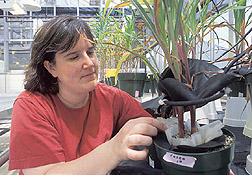This page has been archived and is being provided for reference purposes only. The page is no longer being updated, and therefore, links on the page may be invalid.
|
Read the magazine story to find out more. |
Glomalin, the Unsung Hero of Carbon StorageBy Don ComisSeptember 6, 2002 Glomalin, a recently discovered major component of soil organic matter, stores about a third of the world’s soil carbon, offsetting industrial pollution. This is according to a recent collaborative study by scientists with the Agricultural Research Service and the University of Maryland (U-MD) at College Park. The study was partially funded by the U.S. Department of Energy. The study was done by Kristine A. Nichols, a U-MD soil science Ph.D. candidate and technician at ARS’ Sustainable Agricultural Systems Laboratory in Beltsville, Md., along with colleagues Sara F. Wright and E. Kudjo Dzantor. Wright, an ARS soil scientist, discovered glomalin in 1996, and Dzantor is a U-MD soil scientist. Glomalin is a sticky protein produced by root-dwelling fungi and sloughed into soil as roots grow. By gluing soil particles and organic matter together, it stabilizes soil and keeps carbon from escaping into the atmosphere. In an earlier study, Wright found that glomalin serves as a corrective to global warming because it increases with carbon dioxide levels. Nichols and colleagues detected large amounts of glomalin in soils from four states, showing it to be a major part of organic matter. The glomalin weighed 2 to 24 times as much as humic acid, which was previously thought to store the most carbon. But Nichols found that humic acid only stored 8 percent of total soil carbon compared to glomalin’s 27 percent. Wright has found glomalin in soils from around the world, ranging in weight from less than 1 milligram per gram (mg/g) of sample to more than 100 mg/g. She found the highest levels in Hawaiian and Japanese soils, indicating that some soils might be able to store large amounts of carbon in glomalin with a turnover rate of 7 to 42 years. She is on a team investigating underground carbon storage in tropical forests, thought to be major carbon reservoirs. For more on glomalin, see the September 2002 issue of Agricultural Research magazine. ARS is the U.S. Department of Agriculture’s chief scientific research agency. |


